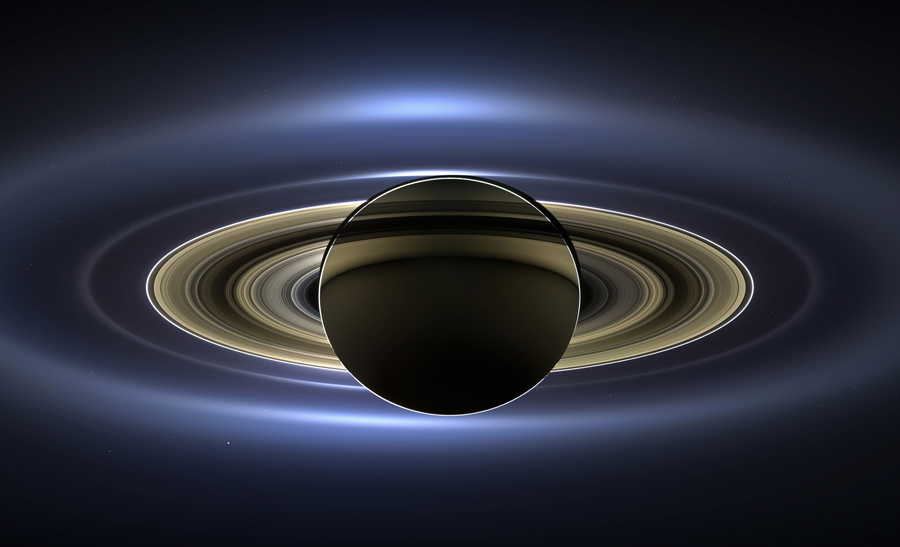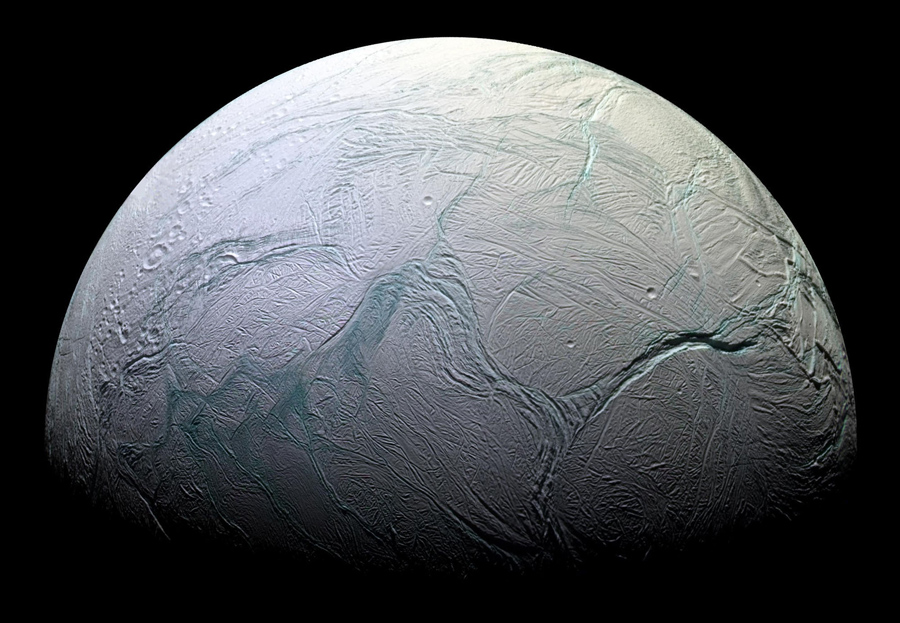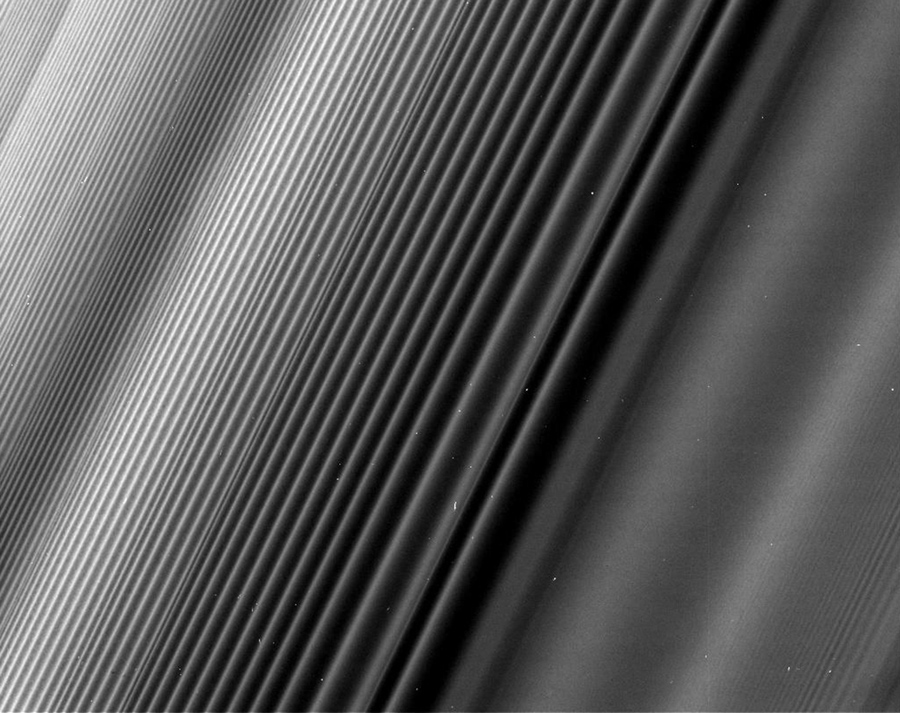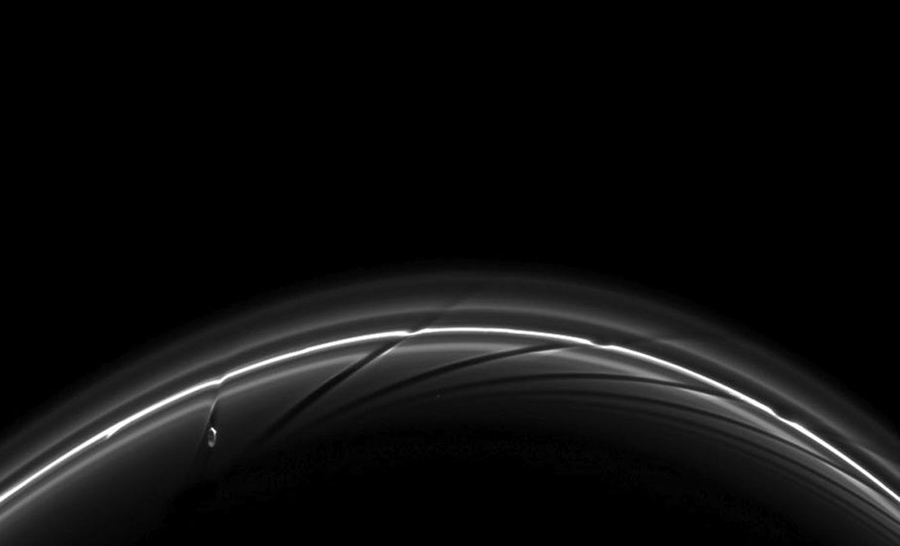This September, NASA’s Cassini spacecraft will take its final measurements and images as it plunges into Saturn’s atmosphere at 77,000 miles per hour, burning up high above the cloud tops. Launched in 1997, Cassini traveled 2.2 billion miles in seven years to reach Saturn and enter orbit.
Over the past 13 years, Cassini’s instruments have returned countless priceless scientific observations and hundreds of thousands of images of the Saturnian system—its atmosphere, its 60+ moons, its vast rings, and much more. Gathered here are 40 of the most amazing images sent to us from Cassini, as we prepare for this epic mission to come to an end in just a few months.
1. A natural-color image of Saturn from space, the first in which Saturn, its moons and rings, and Earth, Venus and Mars, all are visible, is seen in this image taken from the Cassini spacecraft on July 19, 2013. The image captures 404,880 miles (651,591 kilometers) across Saturn and its inner ring system, including all of Saturn's rings out to the E ring, which is Saturn's second outermost ring.

NASA / JPL-Caltech / SSI / Reuters
2. Ring shadows line the face of distant Saturn, providing a backdrop for the brilliant, white sphere of the icy moon Enceladus. The image was taken by the orbiting Cassini spacecraft on June 28, 2007, at a distance of approximately 291,000 kilometers (181,000 miles) from Enceladus. Image scale is approximately 2 kilometers (1 mile) per pixel. #

JPL / Space Science Institute / NASA
3. At first glance, Saturn's rings appear to be intersecting themselves in an impossible way. In actuality, this view from NASA's Cassini spacecraft shows the rings in front of the planet, upon which the shadow of the rings is cast. And because rings like the A ring and Cassini Division, which appear in the foreground, are not entirely opaque, the disk of Saturn and those ring shadows can be seen directly through the rings themselves. The tiny moon Pan (17 miles or 28 kilometers across) can be seen here near image center. The image was taken in visible light with the Cassini spacecraft narrow-angle camera on February 11, 2016, at a distance of approximately 1.2 million miles (1.9 million kilometers) from Pan.

JPL-Caltech / Space Science Institute / NASA
4. This stunning false-color view of Saturn's moon Hyperion reveals crisp details across the strange, tumbling moon's surface. Differences in color could represent differences in the composition of surface materials. The view was obtained during Cassini's close flyby on September 26, 2005. Hyperion has a notably reddish tint when viewed in natural color.
The red color was toned down in this false-color view, and the other hues were enhanced, in order to make more subtle color variations across Hyperion's surface more apparent. Cassini scientists think that Hyperion’s unusual appearance can be attributed to the fact that it has an unusually low density for such a large object, giving it weak surface gravity and high porosity.
These characteristics help preserve the original shapes of Hyperion’s craters by limiting the amount of impact ejecta coating the moon’s surface. Images taken using infrared, green and ultraviolet spectral filters were combined to create this view. The images were taken at a distance of approximately 62,000 kilometers (38,500 miles) from Hyperion. #

JPL / Space Science Institute / NASA
5. An enhanced-color mosaic of Enceladus imaged on October 9, 2008. Craters and cratered terrains are rare in this view of the southern region of the moon's Saturn-facing hemisphere. Instead, the surface is replete with fractures, folds, and ridges—all hallmarks of remarkable tectonic activity for a relatively small world. In this enhanced-color view, regions that appear blue-green are thought to be coated with larger grains than those that appear white or gray. The prominent one-kilometer-deep chasm located on the right side has been named Labtayt Sulci.

JPL / Space Science Institute / NASA
6. A closeup of the surface of Enceladus on November 21, 2009, viewed from approximately 1,260 miles (2,028 kilometers) away. #

JPL / Space Science Institute / NASA
7. Half an hour after the tiny moon Prometheus tore into this region of Saturn's F ring, the Cassini spacecraft snapped this image just as the moon was creating a new streamer in the ring.The dark pattern in the upper left of the image is Prometheus and its shadow.
The potato-shaped moon can just be seen coming back out of the ring. The moon's handiwork also is apparent in two previous streamer-channel formations on the right of the image. The darkest streamer-channel stretching from the top right to the center of the image shows Prometheus' previous apoapse passage about 15 hours earlier. Prometheus (86 kilometers, or 53 miles across) dips into the inner edge of the F ring when it reaches apoapse, the moon's farthest orbital point from Saturn.
At apoapse, the moon's gravity pulls particles of the ring outward into a streamer. As Prometheus moves onward toward periapse—its orbit's closest point to the planet—the streamer gets longer. Then, as Prometheus moves back toward apoapse, the streamer breaks apart which results in a dark channel. The image was taken in visible light on January 14, 2009. The view was obtained at a distance of approximately 555,000 kilometers (345,000 miles) from Saturn.

JPL / Space Science Institute / NASA
8. Saturn's moon, Atlas, imaged on April 12, 2017, by NASA's Cassini spacecraft. The flyby had a close-approach distance of about 7,000 miles (11,000 kilometers). This image is the closest ever taken of Atlas and will help to characterize its shape and geology. Atlas (19 miles, or 30 kilometers across) orbits Saturn just outside the A ring -- the outermost of the planet's bright, main rings. The current theory explaining the large smooth equatorial ridge, which gives the moon a flying-saucer shape, is that the gravitational pull of the moonlet has accumulated countless ring particles around its midsection over recent centuries.

JPL / Space Science Institute / NASA
9. Approaching the moon Dione, with Saturn in the background, on October 11, 2005.

JPL-Caltech / NASA
10. A true color image of Titan's colorful south polar vortex captured by NASA's Cassini spacecraft before a distant flyby of Saturn's moon Titan on June 27, 2012, shows a south polar vortex, or a mass of swirling gas, around the pole in the atmosphere of the moon.
The south pole of Titan which is 3,200 miles (5,150 km) across is near the center of the view. The formation of the vortex at Titan's south pole may be related to the coming southern winter and the start of what will be a south polar hood. #

NASA / JPL-Caltech / Space Science Institute / Reuters
11. The opposition effect, a brightness surge that is visible on Saturn's rings when the sun is directly behind the spacecraft, is captured here as a colorful halo of light moving across Saturn's sunlit rings. The rainbow of color seen here is actually an artifact and a by-product of the spot's movement and the way the color image was produced. Cassini acquires color images by taking sequential exposures using red, green and blue spectral filters, which are then composited together to form a color view.
The bright patch traveled across the rings between exposures taken for this view, creating a series of three colorful spots showing its position at three separate moments. This view looks toward the sunlit side of the rings from about 9 degrees below the ringplane. The images in this view were acquired on June 12, 2007, at a distance of approximately 523,000 kilometers (325,000 miles) from Saturn.

JPL / Space Science Institute / NASA
12. Approximately 47,398 miles (76,280 kilometers) above the moon Iapetus, and its distinct equatorial ridge, on September 10, 2007.

JPL-Caltech / Space Science Institute / NASA
13. During its close flyby of Saturn's moon Mimas on August 2, 2005, Cassini caught a glimpse of Mimas against the broad expanse of Saturn's rings. The Keeler Gap in the outer A ring is at the upper right. The ancient, almost asteroid-like surface of Mimas is evident in its crater-upon-crater appearance. Even the material which has slumped down into the bottom of some of its craters bears the marks of later impacts. This image was taken at a distance of 68,000 kilometers (42,500 miles) from Mimas.

JPL / Space Science Institute / NASA
14. The wavemaker moon, Daphnis, is featured in this view, taken as NASA's Cassini spacecraft made one of its ring-grazing passes over the outer edges of Saturn's rings on January 16, 2017. Daphnis (5 miles across) orbits within the 26-mile wide Keeler Gap.

NASA / JPL-Caltech / Space Science Institute via Getty
15. This natural color image shows Titan's upper atmosphere--an active place where methane molecules are being broken apart by solar ultraviolet light and the byproducts combine to form compounds like ethane and acetylene. The haze preferentially scatters blue and ultraviolet wavelengths of light, making its complex layered structure more easily visible at the shorter wavelengths used in this image. Imaged at a distance of approximately 9,500 kilometers (5,900 miles) from Titan on March 31, 2005.

JPL / Space Science Institute / NASA
16. Rhea before Titan. Saturn's moons Rhea and Titan overlap in this image made on June 11, 2006. Titan is lit from behind, illuminating its hazy atmosphere, with Rhea blocking some of that from Cassini's view.

JPL-Caltech / Space Science Institute / NASA
17. Tight lines in Saturn's rings imaged on June 3, 2017.

JPL-Caltech / Space Science Institute / NASA
18. This view from NASA's Cassini spacecraft looks toward Saturn's icy moon Dione, with giant Saturn and its rings in the background, just prior to the mission's final close approach to the moon on August 17, 2015.

JPL-Caltech / Space Science Institute / NASA
19. Roiling storm clouds and a swirling vortex at the center of Saturn's famed north polar hexagon, in an image from NASA's Cassini mission taken on November 27, 2012. The camera was pointing toward Saturn from approximately 224,618 miles (361,488 kilometers) away.

NASA / JPL-Caltech / Space Science Institute / Reuters
20. Like a cosmic bull's-eye, Enceladus and Tethys line up almost perfectly for Cassini's cameras. Since the two moons are not only aligned, but also at relatively similar distances from Cassini, the apparent sizes in this image are a good approximation of the relative sizes of Enceladus (313 miles or 504 kilometers across) and Tethys (660 miles or 1,062 kilometers across). The image was taken on September 24, 2015 at a distance of approximately 1.3 million miles (2.1 million kilometers) from Enceladus.

JPL-Caltech / Space Science Institute / NASA
21. A swing high above Saturn by NASA's Cassini spacecraft revealed this stately view of the golden-hued planet and its main rings. The view is in natural color, as human eyes would have seen it. This mosaic was made from 36 images in three color filters obtained by Cassini's imaging science subsystem on October 10, 2013.

JPL-Caltech / SSI / Cornell / NASA
22. NASA's Cassini spacecraft spied details on the pockmarked surface of Saturn's moon Prometheus (86 kilometers, or 53 miles across) during a moderately close flyby on December 6, 2015. The image was taken at a distance of approximately 23,000 miles (37,000 kilometers) from Prometheus. Prometheus orbits Saturn just interior to the narrow F ring, which is seen here at top.

JPL-Caltech / Space Science Institute / NASA
23. The swirling tops of Saturn's uppermost cloud layers. This view looks toward the sunlit side of the rings from about 25 degrees above the ringplane. The image was taken on August 23, 2014, at a distance of approximately 1.1 million miles (1.8 million kilometers) from Saturn.

JPL-Caltech / Space Science Institute / NASA
24. The moon Mimas is seen in an image from NASA's Cassini spacecraft taken at a distance of about 9,500 kilometers (5,900 miles) on February 13, 2010. The battered moon may sport a thin global ocean buried miles beneath its icy surface, raising the prospect of another life-friendly habitat in the solar system, according to scientists.

NASA / JPL-Caltech / Space Science Institute / Reuters
25. Vertical structures, among the tallest seen in Saturn's main rings, rise abruptly from the edge of Saturn's B ring to cast long shadows on the ring in this image taken two weeks before the planet's August 2009 equinox.
Part of the Cassini Division, between the B and the A rings, appears at the top of the image, showing ringlets in the inner division. In this image, Cassini's narrow angle camera captured a 1,200-kilometer-long (750-mile-long) section arcing along the outer edge of the B ring. Here, vertical structures tower as high as 2.5 kilometers (1.6 miles) above the plane of the rings -- a significant deviation from the vertical thickness of the main A, B and C rings, which is generally only about 10 meters (about 30 feet). The image was taken on July 26, 2009.

JPL / SSI / NASA
26. A flash of sunlight reflected off a lake on Saturn's moon Titan, observed by NASA's Cassini spacecraft on July 8, 2009. The glint off a mirror-like surface is known as a specular reflection. It confirmed the presence of liquid in the moon's northern hemisphere, where liquid ethane and methane lakes are more numerous and larger than those in the southern hemisphere.

NASA / JPL / University of Arizona / DLR / Reuters
27. This stunning close-up view shows mountainous terrain that reaches about 10 kilometers (6 miles) high along the unique equatorial ridge of Iapetus. The view was acquired during Cassini's only close flyby of the two-toned Saturn moon. Above the middle of the image can be seen a place where an impact has exposed the bright ice beneath the dark overlying material. The image was taken on September 10, 2007, at a distance of approximately 3,870 kilometers (2,400 miles) from Iapetus.

JPL / Space Science Institute / NASA
28. A small and battered reminder of the solar system's violent youth, the ice moon Mimas hurtles around its gas giant parent, Saturn. At 397 kilometers (247 miles) across, Mimas is simply dwarfed by the immensity of Saturn. The planet is more than 300 times as wide as the moon. Mimas is seen here against the night side of Saturn. The planet is faintly lit by sunlight reflecting off its rings. The image was taken on January 20, 2006, at a distance of approximately 1.4 million kilometers (900,000 miles) from Mimas.

JPL / Space Science Institute / NASA
29. The gravity of potato-shaped Prometheus (86 kilometers, or 53 miles across) periodically creates streamer-channels in the F ring, and the moon's handiwork can be seen in the dark channels here.

JPL / Space Science Institute / NASA
30. The north pole of Saturn's icy moon Enceladus is seen in an image from NASA's Cassini spacecraft taken October 14, 2015. The moon's north pole lies approximately at the top of this view from Cassini's wide-angle camera. The view was acquired at a distance of approximately 4,000 miles (6,000 kilometers) from Enceladus.

NASA / JPL / Space Science Institute / Reuters
31. A line of dark vortices charge through Saturn's "Storm Alley"—a region that has seen intensive storm activity since the Cassini spacecraft began its observations of the planet in early 2004. The image was taken on May 19, 2008, at a distance of approximately 863,000 kilometers (536,000 miles) from Saturn.

JPL / Space Science Institute / NASA
32. The Cassini spacecraft successfully completed its second-closest encounter with Saturn's small, icy moon Helene in this image dated June 18, 2011. At closest approach, Cassini flew within 4,330 miles (6,968 kilometers) of Helene's surface. It was the second closest approach to Helene of the entire mission.

NASA / JPL-Caltech / Space Science Institute / Reuters
33. Dazzling Titan glows with a 360-degree sunset as light scatters through its very extended atmosphere. Some structure is visible in the hazes of the northern polar hood. To the left is Janus (181 kilometers, or 113 miles across), far off on the opposite side of the ringplane. The rings show their unlit side to Cassini, as the spacecraft viewed them from slightly above the ringplane. A world with strikingly Earth-like physical processes, frigid Titan is Saturn's largest natural satellite, at 5,150 kilometers (3,200 miles) across.

JPL / Space Science Institute / NASA
34. Saturn's north polar hexagon basks in the Sun's light now that spring has come to the northern hemisphere. Many smaller storms dot the north polar region and Saturn's signature rings, which appear to disappear on account of Saturn's shadow, put in an appearance in the background. The image was taken on November 27, 2012, at a distance of approximately 403,000 miles (649,000 kilometers) from Saturn.

JPL-Caltech / Space Science Institute / NASA
35. This spectacular and disorienting maze of lines is a Cassini portrait of the gas giant Saturn, its rings and its small, icy moon Mimas. The rings cast dark shadows across Saturn's northern hemisphere, creating a photonegative effect: dark sections are dense and block the Sun, while bright sections are less dense areas or gaps in the rings, which are more transparent to sunlight. Saturn's moon Mimas is seen here against the backdrop created by the shadow of the dense B ring. This view was obtained on October 15, 2004, at a distance of approximately 4.7 million kilometers (2.9 million miles) from Saturn.

JPL / Space Science Institute / NASA
36. A close view of Saturn's small moon Helene during a flyby on March 3, 2010. Helene is 33 kilometers, or 21 miles across.

JPL / Space Science Institute / NASA
37. Saturn's brightly sunlit moon Rhea commands the foreground in this image from Cassini. The planet's rings are discernible in the background. Rhea is 1,528 kilometers (949 miles) across.

JPL / Space Science Institute / NASA
38. Saturn's upper atmosphere, with a view of its rings in the background, appearing somewhat distorted by the atmosphere, imaged on June 25, 2005.

JPL-Caltech / Space Science Institute / NASA
39. Cassini looks across the active south pole of Enceladus on November 30, 2010. The polar plumes of ice emerge from cracks in the moon's surface, throwing particles far from the surface, supplying most of the material that makes up Saturn's E ring. #

JPL-Caltech / Space Science Institute / NASA
40. This amazing perspective view captures battered Mimas against the hazy limb of Saturn. It is obvious in such close-up images that Mimas (397 kilometers, or 247 miles across) has been badly scarred by impacts over the eons. The image was taken on March 21, 2006, at a distance of approximately 191,000 kilometers (119,000 miles) from Mimas.

JPL-Caltech / Space Science Institute / NASA
This article was originally Published on The Atlantic.
